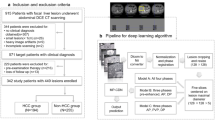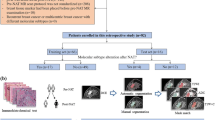Abstract
Objective
To investigate the image quality and lesion conspicuity of a deep-learning-based contrast-boosting (DL-CB) algorithm on double-low-dose (DLD) CT of simultaneous reduction of radiation and contrast doses in participants at high-risk for hepatocellular carcinoma (HCC).
Methods
Participants were recruited and underwent four-phase dynamic CT (NCT04722120). They were randomly assigned to either standard-dose (SD) or DLD protocol. All CT images were initially reconstructed using iterative reconstruction, and the images of the DLD protocol were further processed using the DL-CB algorithm (DLD-DL). The primary endpoint was the contrast-to-noise ratio (CNR), the secondary endpoint was qualitative image quality (noise, hepatic lesion, and vessel conspicuity), and the tertiary endpoint was lesion detection rate. The t-test or repeated measures analysis of variance was used for analysis.
Results
Sixty-eight participants with 57 focal liver lesions were enrolled (20 with HCC and 37 with benign findings). The DLD protocol had a 19.8% lower radiation dose (DLP, 855.1 ± 254.8 mGy·cm vs. 713.3 ± 94.6 mGy·cm, p = .003) and 27% lower contrast dose (106.9 ± 15.0 mL vs. 77.9 ± 9.4 mL, p < .001) than the SD protocol. The comparative analysis demonstrated that CNR (p < .001) and portal vein conspicuity (p = .002) were significantly higher in the DLD-DL than in the SD protocol. There was no significant difference in lesion detection rate for all lesions (82.7% vs. 73.3%, p = .140) and HCCs (75.7% vs. 70.4%, p = .644) between the SD protocol and DLD-DL.
Conclusions
DL-CB on double-low-dose CT provided improved CNR of the aorta and portal vein without significant impairment of the detection rate of HCC compared to the standard-dose acquisition, even in participants at high risk for HCC.
Key Points
• Deep-learning-based contrast-boosting algorithm on double-low-dose CT provided an improved contrast-to-noise ratio compared to standard-dose CT.
• The detection rate of focal liver lesions was not significantly differed between standard-dose CT and a deep-learning-based contrast-boosting algorithm on double-low-dose CT.
• Double-low-dose CT without a deep-learning algorithm presented lower CNR and worse image quality.





Similar content being viewed by others
Abbreviations
- AFP:
-
Serum alpha-fetoprotein
- AP:
-
Arterial phase
- CT:
-
Computed tomography
- DL-CB:
-
Deep-learning-based iodine contrast boosting
- DLD:
-
Double-low dose
- DP:
-
Delayed phase
- DRI:
-
Dose right index
- HCC:
-
Hepatocellular carcinoma
- IMR:
-
Iterative model reconstruction
- PVP:
-
Portal venous phase
- SD:
-
Standard-dose
References
Park W, Chung YH, Kim JA et al (2013) Recurrences of hepatocellular carcinoma following complete remission by transarterial chemoembolization or radiofrequency therapy: focused on the recurrence patterns. Hepatol Res 43:1304–1312
Yang W, Yan K, Goldberg SN et al (2016) Ten-year survival of hepatocellular carcinoma patients undergoing radiofrequency ablation as a first-line treatment. World J Gastroenterol 22:2993
Liu D, Fong DY, Chan AC, Poon RT, Khong P-L (2015) Hepatocellular carcinoma: surveillance CT schedule after hepatectomy based on risk stratification. Radiology 274:133–140
Boas FE, Do B, Louie JD et al (2015) Optimal imaging surveillance schedules after liver-directed therapy for hepatocellular carcinoma. J Vasc Interv Radiol 26:69–73
Nam CY, Chaudhari V, Raman SS et al (2011) CT and MRI improve detection of hepatocellular carcinoma, compared with ultrasound alone, in patients with cirrhosis. Clin Gastroenterol Hepatol 9:161–167
Hanna RF, Miloushev VZ, Tang A et al (2016) Comparative 13-year meta-analysis of the sensitivity and positive predictive value of ultrasound, CT, and MRI for detecting hepatocellular carcinoma. Abdom Radiol (NY) 41:71–90
Lima PH, Fan B, Bérubé J et al (2019) Cost-utility analysis of imaging for surveillance and diagnosis of hepatocellular carcinoma. AJR Am J Roentgenol 213:17–25
Haubold J, Hosch R, Umutlu L et al (2021) Contrast agent dose reduction in computed tomography with deep learning using a conditional generative adversarial network. Eur Radiol 31:6087–6095
Park S-J, Kang D-Y, Sohn K-H et al (2018) Immediate mild reactions to CT with iodinated contrast media: strategy of contrast media readministration without corticosteroids. Radiology 288:710–716
Lee S-Y, Yang MS, Choi Y-H et al (2017) Stratified premedication strategy for the prevention of contrast media hypersensitivity in high-risk patients. Ann Allergy Asthma Immunol 118:339-344 e331
Hunt CH, Hartman RP, Hesley GK (2009) Frequency and severity of adverse effects of iodinated and gadolinium contrast materials: retrospective review of 456,930 doses. AJR Am J Roentgenol 193:1124–1127
Yoon JH, Lee JM, Yu MH et al (2014) Comparison of iterative model–based reconstruction versus conventional filtered Back projection and hybrid iterative reconstruction techniques: lesion conspicuity and influence of body size in anthropomorphic liver phantoms. J Comput Assist Tomogr 38:859–868
Willemink MJ, Noël PB (2019) The evolution of image reconstruction for CT—from filtered back projection to artificial intelligence. Eur Radiol 29:2185–2195
Chang W, Lee JM, Lee K et al (2013) Assessment of a model-based, iterative reconstruction algorithm (MBIR) regarding image quality and dose reduction in liver computed tomography. Invest Radiol 48:598–606
Mayo-Smith WW, Hara AK, Mahesh M, Sahani DV, Pavlicek W (2014) How I do it: managing radiation dose in CT. Radiology 273:657–672
Laurent G, Villani N, Hossu G et al (2019) Full model-based iterative reconstruction (MBIR) in abdominal CT increases objective image quality, but decreases subjective acceptance. Eur Radiol 29:4016–4025
Solomon J, Lyu P, Marin D, Samei E (2020) Noise and spatial resolution properties of a commercially available deep learning-based CT reconstruction algorithm. Med Phys 47:3961–3971
Park S, Yoon JH, Joo I et al (2021) Image quality in liver CT: low-dose deep learning vs standard-dose model-based iterative reconstructions. Eur Radiol 32:2865–2574
Chartrand G, Cheng PM, Vorontsov E et al (2017) Deep learning: a primer for radiologists. Radiographics 37:2113–2131
Kim JH, Yoon HJ, Lee E, Kim I, Cha YK, Bak SH (2021) Validation of deep-learning image reconstruction for low-dose chest computed tomography scan: Emphasis on image quality and noise. Korean J Radiol 22:131
Greffier J, Hamard A, Pereira F et al (2020) Image quality and dose reduction opportunity of deep learning image reconstruction algorithm for CT: a phantom study. Eur Radiol 30:3951–3959
Singh R, Digumarthy SR, Muse VV et al (2020) Image quality and lesion detection on deep learning reconstruction and iterative reconstruction of submillisievert chest and abdominal CT. AJR Am J Roentgenol 214:566–573
Park C, Choo KS, Jung Y, Jeong HS, Hwang J-Y, Yun MS (2021) CT iterative vs deep learning reconstruction: comparison of noise and sharpness. Eur Radiol 31:3156–3164
Chernyak V, Fowler KJ, Kamaya A et al (2018) Liver Imaging Reporting and Data System (LI-RADS) version 2018: imaging of hepatocellular carcinoma in at-risk patients. Radiology 289:816–830
Park HJ, Lee JM, Park SB, Lee JB, Jeong YK, Yoon JH (2016) Comparison of knowledge-based iterative model reconstruction and hybrid reconstruction techniques for liver CT evaluation of hypervascular hepatocellular carcinoma. J Comput Assist Tomogr 40:863–871
Ronneberger O, Fischer P, Brox T (2015) U-net: Convolutional networks for biomedical image segmentationInternational Conference on Medical image computing and computer-assisted intervention. Springer pp 234–241
Won Kim C, Kim JH (2014) Realistic simulation of reduced-dose CT with noise modeling and sinogram synthesis using DICOM CT images. Med Phys 41:011901
Jin H, Heo C, Kim JH (2019) Deep learning-enabled accurate normalization of reconstruction kernel effects on emphysema quantification in low-dose CT. Phys Med Biol 64:135010
Isola P, Zhu J-Y, Zhou T, Efros AA (2017) Image-to-image translation with conditional adversarial networks. Proceedings of the IEEE conference on computer vision and pattern recognition, pp 1125–1134
Kang H-J, Lee JM, Lee SM et al (2019) Value of virtual monochromatic spectral image of dual-layer spectral detector CT with noise reduction algorithm for image quality improvement in obese simulated body phantom. BMC Med Imaging 19:76
Yoon JH, Chang W, Lee ES, Lee SM, Lee JM (2020) Double low-dose dual-energy liver CT in patients at high-risk of HCC: a prospective, randomized, single-center study. Invest Radiol 55:340–348
Elsayes KM, Kielar AZ, Elmohr MM et al (2018) White paper of the Society of Abdominal Radiology hepatocellular carcinoma diagnosis disease-focused panel on LI-RADS v2018 for CT and MRI. Abdom Radiol (NY) 43:2625–2642
Alkadhi H, Euler A (2020) The future of computed tomography: personalized, functional, and precise. Invest Radiol 55:545–555
Akagi M, Nakamura Y, Higaki T et al (2019) Deep learning reconstruction improves image quality of abdominal ultra-high-resolution CT. Eur Radiol 29:6163–6171
Nakamura Y, Higaki T, Tatsugami F et al (2020) Possibility of deep learning in medical imaging focusing improvement of computed tomography image quality. J Comput Assist Tomogr 44:161–167
Grosse Hokamp N, Hoink AJ, Doerner J et al (2018) Assessment of arterially hyper-enhancing liver lesions using virtual monoenergetic images from spectral detector CT: phantom and patient experience. Abdom Radiol (NY) 43:2066–2074
Matsuda M, Tsuda T, Kido T et al (2018) Dual-energy computed tomography in patients with small hepatocellular carcinoma: utility of noise-reduced monoenergetic images for the evaluation of washout and image quality in the equilibrium phase. J Comput Assist Tomogr 42:937–943
Acknowledgements
We thank ClariPI, Ltd. (Seoul, Korea) for providing technical support for the DLICB algorithm. However, the authors maintained complete control of the data and the information submitted for publication at all times.
Funding
This work was supported by TAEJOON Pharm Co., Ltd. (Seoul, Korea) and the Korea Medical Device Development Fund grant funded by the Korean government (the Ministry of Science and ICT, the Ministry of Trade, Industry, and Energy, the Ministry of Health & Welfare, the Ministry of Food and Drug Safety) (RS-2020-KD000226, 1711174549).
Author information
Authors and Affiliations
Corresponding author
Ethics declarations
Guarantor
The scientific guarantor of this publication is Jeong Min Lee.
Conflict of interest
The authors of this manuscript declare no relationships with any companies whose products or services may be related to the subject matter of the article.
Statistics and biometry
Medical Research Collaborating Center (MRCC) of Seoul National University Medical School/Hospital kindly provided statistical advice for this manuscript.
Informed consent
Written informed consent was obtained from all subjects (patients) in this study.
Ethical approval
Institutional Review Board approval was obtained.
Methodology
• prospective
• randomised controlled trial
• performed at one institution
Additional information
Publisher's note
Springer Nature remains neutral with regard to jurisdictional claims in published maps and institutional affiliations.
Supplementary Information
Below is the link to the electronic supplementary material.
Rights and permissions
Springer Nature or its licensor (e.g. a society or other partner) holds exclusive rights to this article under a publishing agreement with the author(s) or other rightsholder(s); author self-archiving of the accepted manuscript version of this article is solely governed by the terms of such publishing agreement and applicable law.
About this article
Cite this article
Kang, HJ., Lee, J.M., Ahn, C. et al. Low dose of contrast agent and low radiation liver computed tomography with deep-learning-based contrast boosting model in participants at high-risk for hepatocellular carcinoma: prospective, randomized, double-blind study. Eur Radiol 33, 3660–3670 (2023). https://doi.org/10.1007/s00330-023-09520-4
Received:
Revised:
Accepted:
Published:
Issue Date:
DOI: https://doi.org/10.1007/s00330-023-09520-4




